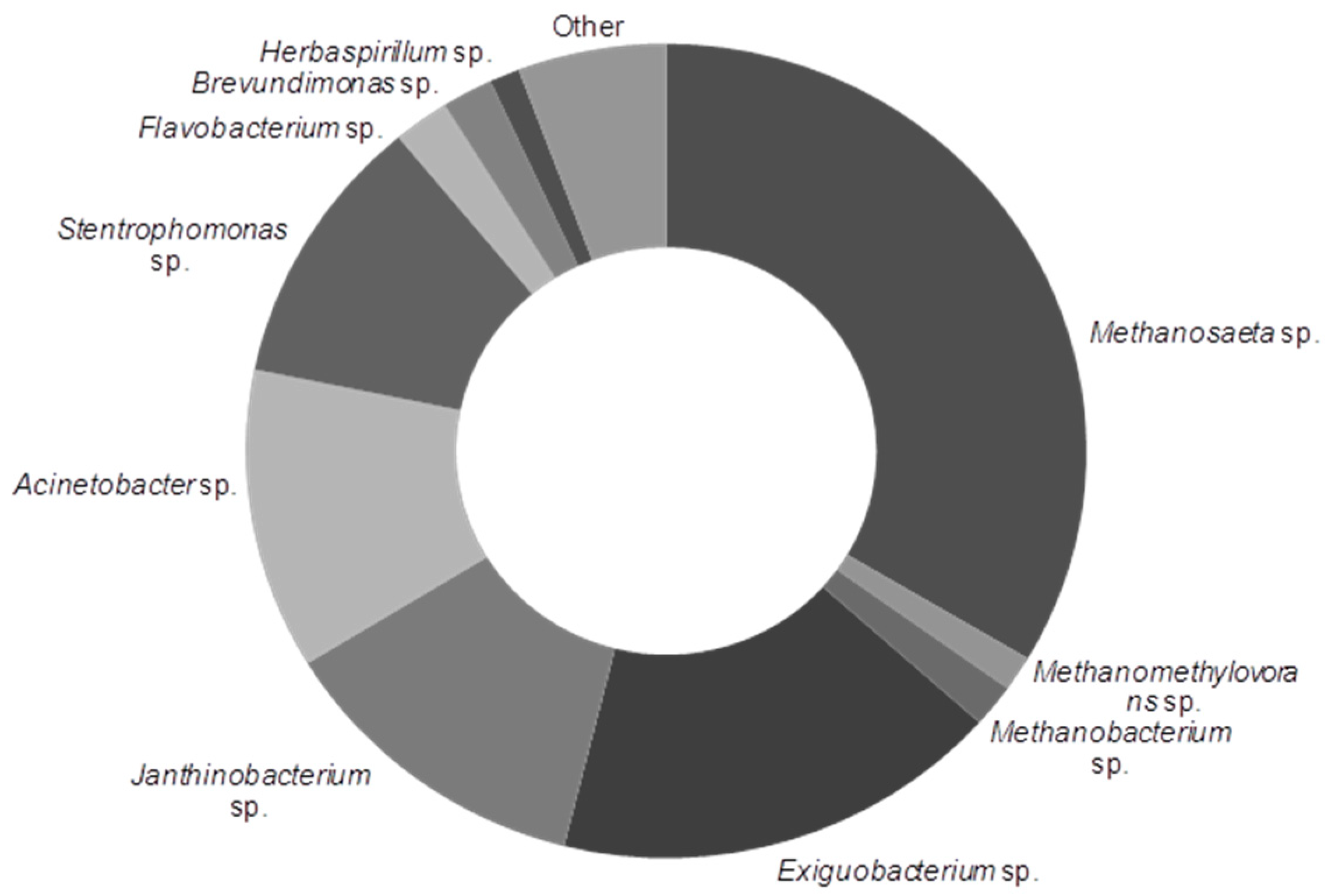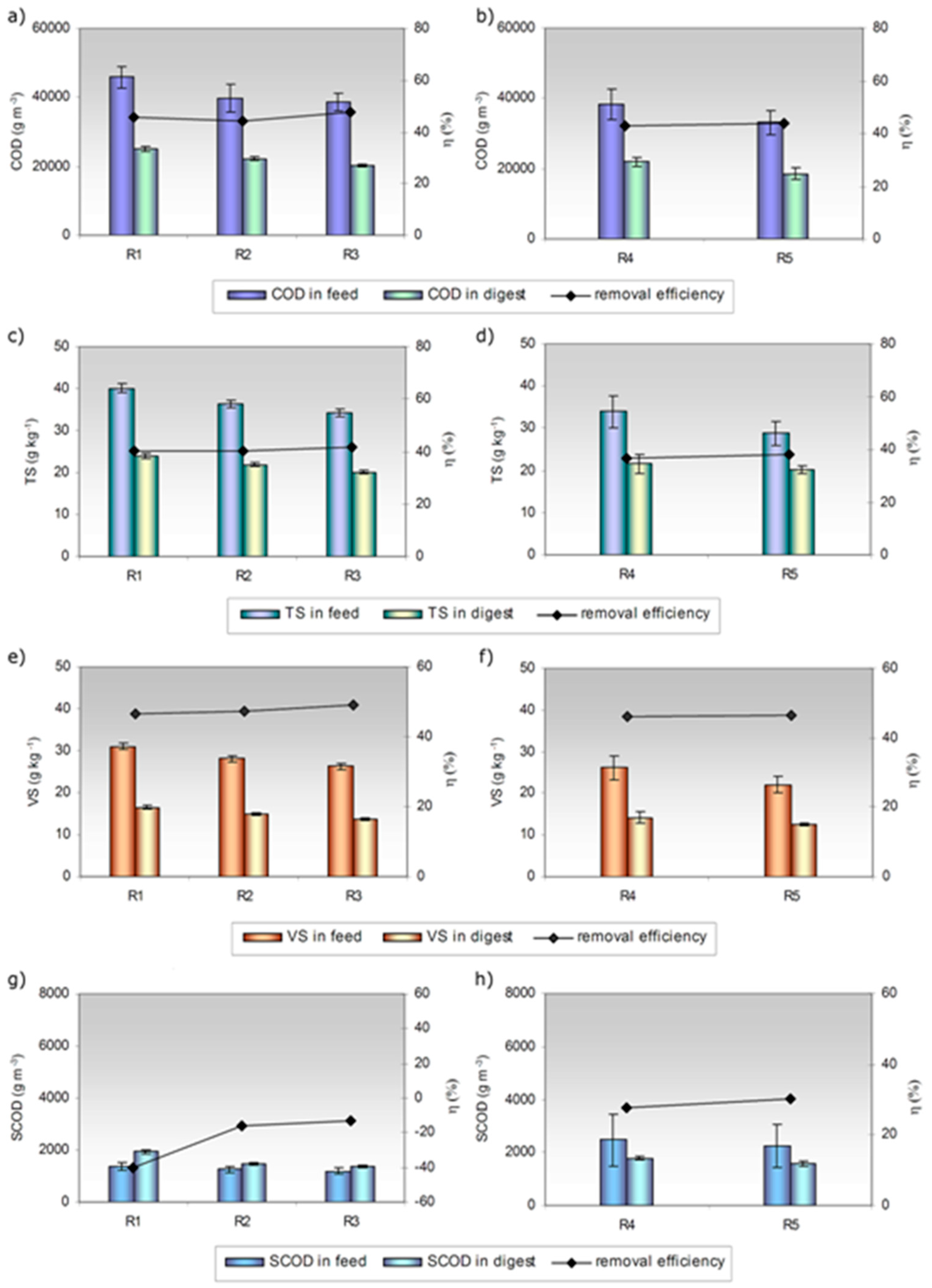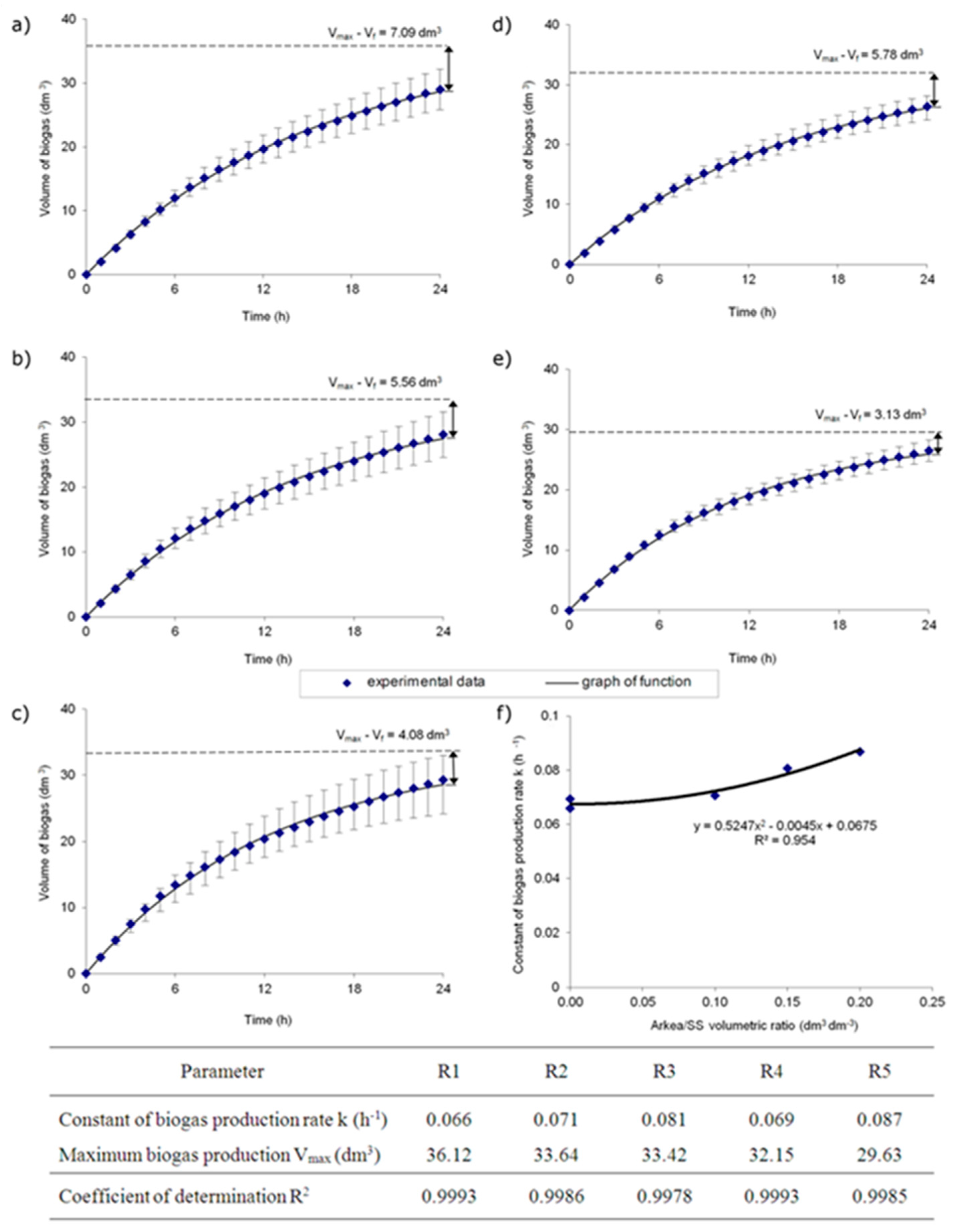Effect of Bioaugmentation on Biogas Yields and Kinetics in Anaerobic Digestion of Sewage Sludge
Abstract
:1. Introduction
2. Materials and Methods
2.1. Material Characteristics
2.2. Laboratory Installation and Operational Set-Up
2.3. Analytical Methods
2.4. Molecular Analysis
3. Results and Discussion
3.1. Impact of Bioaugmentation on the Efficiency of Anaerobic Digestion of Sewage Sludge
3.2. Process Stability
3.3. Biogas Production
3.4. Kinetics
3.5. Changes in Digest Morphology
3.6. Microbial Structure of Digesters
4. Conclusions
Author Contributions
Funding
Conflicts of Interest
References
- Maj Duong, T.H.; Smits, M.; Vestraete, W.; Carballa, M. Enhanced biomethanation of kitchen waste by different pretreatments. Bioresour. Technol. 2011, 102, 592–599. [Google Scholar] [CrossRef]
- Satoh, H.; Okabe, S.; Yamaguchi, Y.; Watanabe, Y. Evaluation of the impact of bioaugmentation and biostimulation by in situ hybridization and microelectrode. Water Res. 2003, 37, 2206–2216. [Google Scholar] [CrossRef]
- Timmis, K.N. Handbook of Hydrocarbon and Lipid Microbiology; Springer: Berlin, Germany, 2010; ISBN 978-3-54-077584-3. [Google Scholar]
- Cycoń, M.; Mrozik, A.; Piotrowska-Seget, Z. Bioaugmentation as a strategy for remediation of pesticide-polluted soil: A review. Chemosphere 2017, 172, 52–71. [Google Scholar] [CrossRef] [PubMed]
- Chen, Q.; Ni, J.; Ma, T.; Liu, T.; Zheng, M. Bioaugmentation treatment of municipal wastewater with heterotrophic-aerobic nitrogen removal bacteria in a pilot-scale SBR. Bioresour. Technol. 2015, 183, 25–32. [Google Scholar] [CrossRef] [PubMed]
- Neumann, L.; Scherer, P. Impact of bioaugmentation by compost on the performance and ecology of an anaerobic digester fed with energy crops. Bioresour. Technol. 2007, 102, 2931–2935. [Google Scholar] [CrossRef] [PubMed]
- Solli, L.; Håvelsrud, O.E.; Horn, S.J.; Rike, A.G. A metagenomic study of the microbial communities in four parallel biogas reactors. Biotechnol. Biofuels 2014, 7, 146. [Google Scholar] [CrossRef] [PubMed] [Green Version]
- Tabatabaei, M.; Rahim, R.A.; Abdullah, N.; Wright, A.-D.G.; Shirai, Y.; Sakai, K.; Sulaiman, A.; Hassan, M.-A. Importance of the methanogenic archaea populations in anaerobic wastewater treatments. Process Biochem. 2010, 45, 1214–1225. [Google Scholar] [CrossRef]
- Nielsen, H.B.; Mladenovska, Z.; Ahring, B.K. Bioaugmentation of a two-stage thermophilic (68 °C/55 °C) anaerobic digestion concept for improvement of the methane yield from cattle manure. Biotechnol. Bioeng. 2007, 97, 1638–1643. [Google Scholar] [CrossRef] [PubMed]
- Li, P.; Wang, Y.; Wang, Y.; Jiang, Z.; Tong, L. Bioaugmentation of cellulose degradation in swine wastewater treatment with a composite microbial consortium. Fresen. Environ. Bull. 2010, 19, 3107–3112. [Google Scholar] [CrossRef]
- Wang, A.; Ren, N.; Shi, Y.; Lee, D.-J. Bioaugmented hydrogen production from microcrystalline cellulose using co-culture—Clostridium acetobutylicum X9 and Ethanoigenensharbinense B49. Int. J. Hydrogen Energy 2008, 33, 912–917. [Google Scholar] [CrossRef]
- Cirne, D.G.; Bjornssom, L.; Alves, M.; Mattiasson, B. Effects of bioaugmentation by an anaerobic lipolytic bacterium on anaerobic digestion of lipid-rich waste. J. Chem. Technol. Biotechnol. 2006, 81, 1745–1752. [Google Scholar] [CrossRef] [Green Version]
- Venkiteshwaran, K.; Milferstedt, K.; Hamelin, J.; Zitomer, D.H. Anaerobic digester bioaugmentation influences quasi steady state performance and microbial community. Water Res. 2016, 104, 128–136. [Google Scholar] [CrossRef] [PubMed]
- Schmidt, J.E.; Larsen, S.B.; Karakashev, D. Ex-situ bioremediation of polycyclic aromatic hydrocarbons in sewage sludge. WIT Trans. Ecol. Environ. 2008, 10, 189–198. [Google Scholar] [CrossRef]
- Poszytek, K.; Pyzik, A.; Sobczak, A.; Lipinski, L.; Sklodowska, A.; Drewniak, L. The effect of the source of microorganisms on adaptation of hydrolytic consortia dedicated to anaerobic digestion of maize silage. Anaerobe 2017, 46, 46–55. [Google Scholar] [CrossRef] [PubMed]
- Li, Y.; Zhang, Y.; Sun, Y.; Wu, S.; Kong, X.; Yuan, Z.; Dong, R. The performance efficiency of bioaugmentation to prevent anaerobic digestion failure from ammonia and propionate inhibition. Bioresour. Technol. 2017, 231, 94–100. [Google Scholar] [CrossRef] [PubMed] [Green Version]
- Schauer-Gimenez, A.E.; Zitomer, D.H.; Maki, J.H.; Struble, C.A. Bioaugmentation for improved recovery of anaerobic digesters after toxicant exposure. Water Res. 2010, 44, 3555–3564. [Google Scholar] [CrossRef] [PubMed]
- Tale, V.P.; Maki, J.S.; Zitomer, D.H. Bioaugmentation of overloaded anaerobic digesters restores function and archaeal community. Water Res. 2015, 70, 138–147. [Google Scholar] [CrossRef] [PubMed] [Green Version]
- Herrero, M.; Stuckey, D.C. Bioaugmentation and its application in wastewater treatment: A review. Chemosphere 2015, 140, 119–128. [Google Scholar] [CrossRef] [PubMed]
- Mehariya, S.; Patel, A.K.; Obulisamy, P.K.; Punniyakotti, E.; Wong, J.W.C. Co-digestion of food waste and sewage sludge for methane production: Current status and perspective. Bioresour. Technol. 2018. [Google Scholar] [CrossRef] [PubMed]
- Raper, E.; Stephenson, T.; Anderson, D.R.; Fisher, R.; Soares, A. Industrial wastewater treatment through bioaugmentation. Process Saf. Environ. Prot. 2018, 118, 178–187. [Google Scholar] [CrossRef]
- Zhang, Q.-Q.; Yang, G.-F.; Zhang, L.; Zhang, Z.-Z.; Tia, G.-M.; Jin, R.-C. Bioaugmentation as a useful strategy for performance enhancement in biological wastewater treatment undergoing different stresses: Application and Mechanisms. Crit. Rev. Environ. Sci. Technol. 2017, 47, 1877–1899. [Google Scholar] [CrossRef]
- American Public Health Association. Standard Methods for the Examination of Water & Wastewater, Centennial Edition 21 ed.; American Public Health Association: Washington, DC, USA, 2005. [Google Scholar]
- Świątczak, P.; Cydzik-Kwiatkowska, A.; Rusanowska, A. Microbiota of anaerobic digesters in full-scale wastewater treatment plant. Arch. Environ. Prot. 2017, 43, 53–60. [Google Scholar] [CrossRef]
- Edgar, R.C.; Haas, B.J.; Clemente, J.C.; Quince, C.; Knight, R. UCHIIME improves sensitivity and speed of chimera detection. Bioinformatics 2011, 27, 2194–2200. [Google Scholar] [CrossRef] [PubMed]
- Edgar, R.C. Search and clustering orders of magnitude faster than BLAST. Bioinformatics 2010, 26, 2460–2461. [Google Scholar] [CrossRef] [PubMed] [Green Version]
- Nawrocki, E.P.; Eddy, S.R. Infernal 1. 1, 100-fold faster RNA homology searches. Bioinformatics 2013, 29, 2933–2935. [Google Scholar] [CrossRef] [PubMed]
- Hill, T.C.J.; Walsh, K.A.; Harris, J.A.; Moffett, B.A. Using ecological diversity measures with bacterial communities. FEMS Microbiol. Ecol. 2003, 43, 1–11. [Google Scholar] [CrossRef] [PubMed] [Green Version]
- Yu, D.; Yang, Y.; Teng, F.; Feng, L.; Fang, X.; Ren, H. Bioaugmentation treatment of mature landfill leachate by new isolated ammonia nitrogen and humic acid resistant microorganisms. J. Microbiol. Biotechnol. 2014, 24, 987–997. [Google Scholar] [CrossRef] [PubMed]
- Hailei, W.; Guosheng, L.; Ping, L.; Feng, P. The effect of bioaugmentation on the performance of sequencing batch reactor and sludge characteristics in the treatment process of papermaking wastewater. Bioprocess Biosyst. Eng. 2006, 29, 283–289. [Google Scholar] [CrossRef] [PubMed]
- Duran, M.; Tepe, N.; Yurtsever, D.; Punzi, V.L.; Bruno, C.; Mehta, R.J. Bioaugmenting anaerobic digestion of biosolids with selected strains of Bacillus, Pseudomonas, and Actinomycetes species for increased methanogenesis and odor control. Appl. Microbiol. Biotechnol. 2006, 73, 960–966. [Google Scholar] [CrossRef] [PubMed]
- Poszytek, K.; Karczewska-Golec, J.; Jakusz, G.; Krucon, T.; Lomza, P.; Zhenfdong, Y.; Drewniak, L.; Ciok, A.; Decewicz, P.; Dziurzynski, M.; et al. Genome-Guided characterization of Ochrobactrum sp. POC9 enhancing sewage sludge utilization—Biotechnological potential and biosafety consideration. Int. J. Environ. Res. Public Health 2018, 15, 1501. [Google Scholar] [CrossRef] [PubMed]
- Gavala, N.H.; Angelidaki, I.; Ahring, B.K. Kinetics and modeling of anaerobic digestion process. Adv. Biochem. Eng. Biotechnol. 2002, 81, 57–93. [Google Scholar]
- Sheng, G.-P.; Yu, H.-Q.; Li, X.-Y. Extracellular polymeric substances (EPS) of microbial aggregates in biological wastewater treatment systems: A review. Biotechnol. Adv. 2010, 28, 882–894. [Google Scholar] [CrossRef] [PubMed]
- Yang, Z.H.; Xu, R.; Zheng, Y.; Chen, T.; Zhao, L.-J.; Li, M. Characterization of extracellular polymeric substances and microbial diversity in anaerobic co-digestion reactor treated sewage sludge with fat, oil, grease. Bioresour. Technol. 2016, 212, 164–173. [Google Scholar] [CrossRef] [PubMed]
- Mikkelsen, L.H.; Keiding, K. Physico-chemical characteristics of full scale sewage sludges with implication to dewatering. Water Res. 2002, 36, 2451–2462. [Google Scholar] [CrossRef]
- Yu, Z.; Wen, X.; Xu, M.; Huang, X. Characteristics of extracellular polymeric substances and bacterial communities in an anaerobic membrane bioreactor coupled with online ultrasound equipment. Bioresour. Technol. 2012, 117, 333–340. [Google Scholar] [CrossRef] [PubMed]
- Dohnalkova, A.C.; Marshall, M.J.; Arey, B.W.; Williams, K.H.; Bukc, E.C.; Fredrickson, J.K. Imaging hydrated microbial extracellular polymers: Comparative analysis by electron microscopy. Appl. Environ. Microbiol. 2017, 77, 1254–1262. [Google Scholar] [CrossRef] [PubMed]
- Zhang, J.; Dong, H.; Zhao, L.; McCarrick, R.; Agrawal, A. Microbial reduction and precipitation of vanadium by mesophilic and thermophilic methanogens. Chem. Geol. 2014, 370, 29–39. [Google Scholar] [CrossRef]
- Li, A.; Chu, Y.; Wang, X.; Ren, R.; Yu, J.; Liu, X.; Yan, J.; Zhang, L.; Wu, S.; Li, S. A pyrosequencing-based metagenomic study of methane-producing microbial community in solid-state biogas reactor. Biotechnol. Biofuels 2013, 6, 3. [Google Scholar] [CrossRef] [PubMed]
- Venkiteshwaran, K.; Bocher, B.; Maki, J.; Zitomer, D.H. Relating Anaerobic Digestion Microbial Community and Process Function. Microbiol. Insights 2015, 8, 37–44. [Google Scholar] [CrossRef] [PubMed]
- Haack, S.H.; Breznak, J.A. Cytophaga xylanolytica sp. nov., a xylan-degrading, anaerobic gliding bacterium. Arch. Microbiol. 1993, 159, 6–15. [Google Scholar] [CrossRef]
- Xia, S.; Zhou, Y.; Eustance, E.; Zhang, Z. Enhancement mechanisms of short-time aerobic digestion for waste activated sludge in the presence of cocoamidopropyl betaine. Sci. Rep. 2017, 7, 13491. [Google Scholar] [CrossRef] [PubMed] [Green Version]
- Pelletier, E.; Kreymeyer, A.; Bocs, S.; Rouy, Z.; Gyapay, G.; Chouari, R.; Riviere, D.; Ganesan, P.; Daegelen, A.; Sghir, A.; et al. “Candidatus Cloacamonas acidaminovorans”: Genome sequence reconstruction provides a first glimpse of a new bacterial division. J. Bacteriol. 2008, 190, 2572–2579. [Google Scholar] [CrossRef] [PubMed]
- Jackson, B.E.; Bhupathiraju, V.K.; Tanner, R.S.; Woese, C.R.; McInerney, M.J. Syntrophus aciditrophicus sp. nov., a new anaerobic bacterium that degrades fatty acids and benzoate in syntrophic association with hydrogen-using microorganisms. Arch. Microbiol. 1999, 171, 107–114. [Google Scholar] [CrossRef] [PubMed]
- Zielińska, M.; Cydzik-Kwiatkowska, A.; Zieliński, M.; Dębowski, M. Impact of temperature, microwave radiation and organic loading rate on methanogenic community and biogas production during fermentation of dairy wastewater. Bioresour. Technol. 2013, 129, 308–314. [Google Scholar] [CrossRef] [PubMed]





| Reactor | Value | VFA (g m−3) | Alkalinity (g CaCO3 m−3) | pH | |||
|---|---|---|---|---|---|---|---|
| Feed | Digest | Feed | Digest | Feed | Digest | ||
| R1 | Average | 838 | 235 | 812 | 3722 | 6.81 | 7.99 |
| lower/upper 95% mean | 719/957 | 66/404 | 764/860 | 3614/3830 | 6.68/6.94 | 7.95/8.03 | |
| R2 | Average | 771 | 241 | 769 | 3391 | 6.83 | 7.86 |
| lower/upper 95% mean | 678/864 | 112/370 | 732/806 | 3268/3514 | 6.70/6.96 | 7.80/7.92 | |
| R3 | Average | 660 | 291 | 749 | 3336 | 6.82 | 7.72 |
| lower/upper 95% mean | 542/778 | 203/379 | 712/786 | 3229/3443 | 6.68/6.96 | 7.66/7.78 | |
| R4 | Average | 1520 | 149 | 880 | 3670 | 6.68 | 7.71 |
| lower/upper 95% mean | 147/2893 | 115/183 | 610/1150 | 3524/3816 | 6.44/6.92 | 7.44/7.98 | |
| R5 | Average | 1062 | 253 | 754 | 3195 | 6.75 | 7.59 |
| lower/upper 95% mean | 163/1961 | 167/339 | 578/930 | 3078/3312 | 6.53/6.97 | 7.37/7.81 | |
| Parameter | Unit | R1 (Control) | R2 | R3 | R4 (Control) | R5 |
|---|---|---|---|---|---|---|
| Daily biogas production a | dm3 d−1 | 23.23 ± 3.7 b | 24.26 ± 3.8 | 24.53 ± 3.8 | 19.59 ± 2.2 | 19.86 ± 2.1 |
| Biogas yield | m3 kg−1 VS added | 0.38 ± 0.07 | 0.40 ± 0.07 | 0.40 ± 0.07 | 0.38 ± 0.05 | 0.37 ± 0.05 |
| m3 kg−1 TS added | 0.29 ± 0.05 | 0.31 ±0.05 | 0.31 ±0.05 | 0.29 ±0.04 | 0.29 ±0.04 | |
| m3 kg−1 VS removed | 0.83 ± 0.20 | 0.86 ± 0.21 | 0.84 ± 0.21 | 0.82 ± 0.22 | 0.83 ± 0.22 | |
| m3 kg−1 TS removed | 0.75 ± 0.18 | 0.78 ± 0.21 | 0.77 ± 0.19 | 0.79 ±0.27 | 0.78 ± 0.29 | |
| m3 kg−1 COD removed | 0.52 ± 0.09 | 0.53 ± 0.11 | 0.53 ±0.11 | 0.55 ± 0.09 | 0.55 ± 0.13 | |
| Methane content | % | 56.25 ± 1.93 | 56.56 ± 1.58 | 56.16 ± 2.06 | 55.22 ± 1.98 | 55.57 ± 2.50 |
| Kingdom; Phylum; Class; Order; Family; Genus | R1 | R2 | R3 |
|---|---|---|---|
| Bacteria; Verrucomicrobia; Verrucomicrobiae; Verrucomicrobiales; Unclassified | 3.1 | 1.0 | 0.4 |
| Bacteria; Unclassified | 31.0 | 38.8 | 52.7 |
| Bacteria; Thermotogae; Thermotogae; Thermotogales; Unclassified | 4.4 | 2.8 | 4.2 |
| Bacteria; Synergistetes; Synergistia; Synergistales; Synergistaceae; Synergistes | 0.5 | 0.3 | 0.1 |
| Bacteria; Spirochaetes; Unclassified | 2.8 | 3.9 | 3.9 |
| Bacteria; Spirochaetes; Spirochaetia; Unclassified | 0.8 | 0.3 | 0.3 |
| Bacteria; Proteobacteria; Unclassified | 0.4 | 0.5 | 0.3 |
| Bacteria; Proteobacteria; Gammaproteobacteria; Xanthomonadales; Xanthomonadaceae; Thermomonas | 0.5 | 0.4 | 0.3 |
| Bacteria; Proteobacteria; Gammaproteobacteria; Pseudomonadales; Pseudomonadaceae; Pseudomonas | 0.8 | 3.9 | 3.6 |
| Bacteria; Proteobacteria; Deltaproteobacteria; Syntrophobacterales; Unclassified; Unclassified | 0.8 | 1.2 | 0.8 |
| Bacteria; Proteobacteria; Deltaproteobacteria; Syntrophobacterales; Syntrophaceae; Syntrophus | 1.4 | 1.8 | 1.7 |
| Bacteria; Proteobacteria; Deltaproteobacteria; Syntrophobacterales; Syntrophaceae; Smithella | 0.9 | 0.8 | 0.7 |
| Bacteria; Proteobacteria; Deltaproteobacteria; Desulfobacterales; Desulfobacteraceae; Desulfofaba | 0.7 | 1.3 | 1.0 |
| Bacteria; Proteobacteria; Betaproteobacteria; Rhodocyclales; Rhodocyclaceae; Dechloromonas | 0.5 | 0.4 | 0.3 |
| Bacteria; Proteobacteria; Betaproteobacteria; Burkholderiales; Comamonadaceae; Rhodoferax | 1.3 | 1.0 | 0.7 |
| Bacteria; Proteobacteria; Betaproteobacteria; Burkholderiales; Comamonadaceae; Diaphorobacter | 0.8 | 0.8 | 0.5 |
| Bacteria; Proteobacteria; Betaproteobacteria; Burkholderiales; Comamonadaceae; Acidovorax | 0.5 | 0.4 | 0.4 |
| Bacteria; Firmicutes; Unclassified | 0.8 | 0.7 | 0.3 |
| Bacteria; Firmicutes; Clostridia; Clostridiales; Clostridiaceae; Clostridium | 0.5 | 0.5 | 0.3 |
| Bacteria; Cloacimonetes; Unclassified | 7.1 | 6.5 | 3.6 |
| Bacteria; Chloroflexi; Unclassified | 1.2 | 0.7 | 0.5 |
| Bacteria; Chloroflexi; Anaerolineae; Anaerolineales; Unclassified | 1.4 | 0.8 | 0.4 |
| Bacteria; Bacteroidetes; Sphingobacteriia; Sphingobacteriales; Unclassified; Unclassified | 0.7 | 0.4 | 0.3 |
| Bacteria; Bacteroidetes; Cytophagia; Cytophagales; Cytophagaceae; Cytophaga | 18.9 | 16.8 | 12.3 |
| Bacteria; Bacteroidetes; Bacteroidia; Bacteroidales; Bacteroidaceae; Bacteroides | 1.9 | 0.7 | 0.6 |
| Bacteria; Actinobacteria; Actinobacteria; Micrococcales; Intrasporangiaceae; Tetrasphaera | 0.5 | 0.4 | 0.4 |
| Bacteria; Actinobacteria; Actinobacteria; Micrococcales; Dermatophilaceae; Dermatophilus | 1.1 | 0.8 | 0.7 |
| Archaea; Unclassified | 0.5 | 0.4 | 0.3 |
| Archaea; Euryarchaeota; Methanomicrobia; Methanomicrobiales; Methanomicrobiaceae; Methanoculleus | 0.8 | 1.0 | 1.0 |
| Low abundance * | 9.2 | 7.5 | 5.4 |
| No Hit | 4.5 | 3.5 | 2.1 |
© 2018 by the authors. Licensee MDPI, Basel, Switzerland. This article is an open access article distributed under the terms and conditions of the Creative Commons Attribution (CC BY) license (http://creativecommons.org/licenses/by/4.0/).
Share and Cite
Lebiocka, M.; Montusiewicz, A.; Cydzik-Kwiatkowska, A. Effect of Bioaugmentation on Biogas Yields and Kinetics in Anaerobic Digestion of Sewage Sludge. Int. J. Environ. Res. Public Health 2018, 15, 1717. https://doi.org/10.3390/ijerph15081717
Lebiocka M, Montusiewicz A, Cydzik-Kwiatkowska A. Effect of Bioaugmentation on Biogas Yields and Kinetics in Anaerobic Digestion of Sewage Sludge. International Journal of Environmental Research and Public Health. 2018; 15(8):1717. https://doi.org/10.3390/ijerph15081717
Chicago/Turabian StyleLebiocka, Magdalena, Agnieszka Montusiewicz, and Agnieszka Cydzik-Kwiatkowska. 2018. "Effect of Bioaugmentation on Biogas Yields and Kinetics in Anaerobic Digestion of Sewage Sludge" International Journal of Environmental Research and Public Health 15, no. 8: 1717. https://doi.org/10.3390/ijerph15081717





